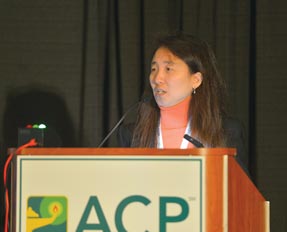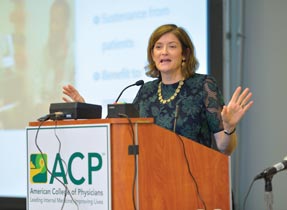How to manage sinusitis, CAP in outpatients
It might require a little detective work before offering a cure to patients with common outpatient infections such as sinusitis and community-acquired pneumonia (CAP).
Patients with common outpatient infections such as sinusitis and community-acquired pneumonia (CAP) seek relief, which requires a little detective work before offering a cure. George C. Mejicano, MD, MS, FACP, offered tips and tricks on how to appropriately manage these and other infections during his session, “Pearls and Pitfalls of Common Outpatient Infections,” at Internal Medicine Meeting 2016.
Sinusitis
Most sinusitis cases diagnosed in the outpatient setting are typically caused by uncomplicated viral upper respiratory infections, said Dr. Mejicano, professor of medicine and senior associate dean for education at Oregon Health & Science University. Features that predict sinusitis are maxillary toothache, purulent secretion by exam, poor response to decongestants, abnormal sinus transillumination, and history of colored nasal discharge, Dr. Mejicano said.
An opaque result from sinus transillumination correlates very well with positive sinus aspirates, Dr. Mejicano said. “Most of us don't do this clinically, but if you want to go back and be a little bit old-school, this is a trick you might want to look at,” he said. Sinus radiography is not recommended for diagnosis in routine cases because scans may be too sensitive, Dr. Mejicano said.
Only about 0.5% to 2% of patients see their common colds progress to acute bacterial sinusitis, he noted, but there's a problem with diagnosis. “It turns out that most of us are actually not very good at diagnosing bacterial rhinosinusitis,” said Dr. Mejicano. This is because bacterial and viral sinusitis are difficult to distinguish on clinical grounds, he added.
Internists should watch out for “double sickening,” or worsening of symptoms after a period of initial improvement, as most people with the common cold experience their worst symptoms on either the second or third day of illness before rebounding, he said. If symptoms start to worsen beyond those first couple days, that is a “very important sign” that may suggest a bacterial infection, Dr. Mejicano said. The other most useful signs and symptoms of bacterial sinusitis include purulent nasal discharge, maxillary tooth pain or facial pain (especially unilateral), and unilateral maxillary sinus tenderness, he said.
In the medical management of sinusitis, steam and saline relieve symptoms by preventing crusting and liquefying secretions, and decongestants help to increase ostial diameter, although rebound congestion is a concern, Dr. Mejicano said. Acute sinusitis resolves without antimicrobial treatment in most cases, he said. Antibiotics eradicate bacterial infection, but there are conflicting data on their efficacy for treating bacterial sinusitis. “They do have some benefits ... but the placebo effect is quite big—over 40%,” Dr. Mejicano said.
Symptomatic treatment is the preferred initial therapy for sinusitis, but patients who should receive antibiotics are those with 3 to 4 days of severe symptoms (e.g., fever, purulent drainage, facial pain), worsening symptoms after initial improvement, or lack of improvement after 10 days, according to 2012 Infectious Diseases Society of America (IDSA) guidelines.
When needed, amoxicillin-clavulanate and doxycycline are recommended as first-line antibiotics, typically given for 5 to 7 days in adults, Dr. Mejicano said. But try not to limit therapy to antibiotics. “Bacterial sinusitis is really an abscess in your head, and so what you should think about is not only treating the infection but also draining the abscess. That means opening up [the] ostium,” said Dr. Mejicano.
CAP
Older patients are at the highest risk of CAP, which is “a very big problem, and we need to be better at treating it,” Dr. Mejicano said. IDSA guidelines issued in 2007 (which are scheduled to be updated) note that radiography or other imaging is required for a CAP diagnosis, although a sputum sample and other routine diagnostic tests to identify an etiologic diagnosis are optional.
“I don't know the best time to get an X-ray relative to symptom onset. However, if you're going to say they have pneumonia, you really should get a film,” Dr. Mejicano said, although he does not recommend routine follow-up imaging. He added that most of the time in the outpatient setting, not a lot of tests are needed.
Although Streptococcus pneumoniae is the No. 1 cause of CAP in the U.S., this changes in the summer months, when atypical Mycoplasma pneumoniae becomes the more common cause, Dr. Mejicano said. “So if you have a patient with CAP in August, it's actually more likely Mycoplasma and not pneumococcus, so just keep that in mind,” he said.
In 98% of decisions on CAP management, the initial assessment of severity drives treatment, Dr. Mejicano added. “It's both science and art,” he said, as initial assessments should be based on a severity-of-illness score (e.g., CURB-65) and clinical judgment by the physician (e.g., determining ability to take oral medications). The CURB-65 factors in confusion, uremia, respirations, blood pressure, and age to calculate mortality risk and recommend a site of care. Scores of 0 and 1 correspond to outpatient treatment, a score of 2 means treatment in an inpatient ward, and scores from 3 to 5 necessitate ICU care.
IDSA guidelines on drug choice and duration suggest using a macrolide (erythromycin, azithromycin, or clarithromycin) or doxycycline, based on strong and weak levels of evidence, respectively. For patients with chronic lung, heart, liver, or renal disease; alcoholism; no spleen; malignancies; immunosuppression; or use of antibiotics within the past 3 months, guidelines strongly recommend respiratory fluoroquinolone or beta-lactam plus a macrolide.
Dr. Mejicano said his personal and guideline-based recommendations are doxycycline in outpatients with mild CAP; azithromycin and high-dose amoxicillin in outpatients with moderate CAP who have recently taken antibiotics; and azithromycin and cefuroxime in outpatients with moderate CAP and comorbidities. For ward inpatients with moderate CAP, he recommends IV ceftriaxone and IV azithromycin before starting oral cefuroxime and oral azithromycin. For ICU patients with severe CAP, he suggests cefepime and ciprofloxacin.
The minimum duration of treatment for CAP is 5 days, and there should be no fevers for 2 to 3 days, Dr. Mejicano said. “You want to make sure ... they're well enough to adhere to [the treatment regimen],” he said.





